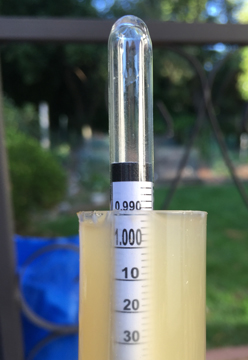 The primary fermentation in the qvevri completed a few days ago. Yesterday I took the specific gravity reading and it measured below 1.000. After cleaning the qvevri’s lip and a few inches down with a paper towel and a bit of potassium metabisulfite, I sealed the qvevri with a ring of clay and a lid I made for the autumn months. For the winter months, I use a solid glass lid. For the autumn months, I use a plexiglass lid with a hole in the middle. In this hole I placed an airlock. I did taste the wine yesterday – very citrus and acidic. I’m hoping that natural malolactic fermentation will take place over the next few months to soften the acid.
The primary fermentation in the qvevri completed a few days ago. Yesterday I took the specific gravity reading and it measured below 1.000. After cleaning the qvevri’s lip and a few inches down with a paper towel and a bit of potassium metabisulfite, I sealed the qvevri with a ring of clay and a lid I made for the autumn months. For the winter months, I use a solid glass lid. For the autumn months, I use a plexiglass lid with a hole in the middle. In this hole I placed an airlock. I did taste the wine yesterday – very citrus and acidic. I’m hoping that natural malolactic fermentation will take place over the next few months to soften the acid.
Challenges
This year’s fermentation went well. After dealing with the qvevri overflowing during fermentation, our next challenge was the area around the qvevri flooding. We had a multi-day nor’easter last week that caused run-off water to fill around the qvevri. I had to soak it up a few times. I did place tarps around and over the qvevri, but water still found its way in. The top of the qvevri is surrounded by bricks and mortar and is eight inches below the ground level. I did reset some on the ground level brickwork so that water would drain away from the qvevri. We had so much rain with the storm that if we get another like it, I expect that water around the qvevri will happen.
Another challenge was the low brix level of the grapes. At harvest the brix level measured 17º Brix and a hydrometer reading of 1.070. It is hard to second guess mother nature. A day after we received the grapes, it rained. Then it rained again. Then came the nor’easter. In retrospect, the vineyard manager made the right call, narrowly missing a tearful sky. I did chaptalize a bit raising the brix level to 20º Brix with a specific gravity reading of 1.080. I’ll be happy with a wine between 11% and 12% alcohol.
Future Plans
I’ll leave the wine in the qvevri alone for now. Prior to Thanksgiving, I’ll remove the present lid and replace the clay ring with new clay and place a solid glass lid on the qvevri. We will then fill the space above the qvevri with sand to ground level and the cover with soil and tarps. Depending on the weather next March, I’ll open the qvevri and rack the wine into a carboy to clarify for a few days. Last year the wine did not clarify in the qvevri but did clarify after I racked into a carboy. The vortex thing occurred in the qvevri and kept some of the smaller particles suspended in the wine. After a few days those particles settled and I was able to filter and bottle.
Cheers
Terry



Sorry if I’m stating the obvious, but you’re not seriously trusting a hydrometer for sugar dryness are you?
That is why I placed an airlock in the lid. On the chemistry side I could use Clinitest Reagent Tablets.